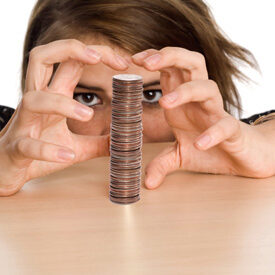Chris Donato collects coins. Among them is the America the Beautiful series of 56 quarters that began in 2010 and celebrates national parks and other scenic wonders.
What few people know is that the U.S. government actually makes a profit on these and other quarters, since they cost less to mint – or make — than their face value. The profit goes into the U.S. Treasury and helps pay down the national debt – the money owed by the U.S. government. “The government loses money in so many other places that it has to make money somehow,” says Donato, 18, a graduate of Hendrick Hudson High School in Montrose, N.Y., who now attends Siena College in Loudonville, N.Y.
Creating Seigniorage
In fact, minting coins is a valuable source of income for the federal government. The profit it creates is called “seigniorage,” a term that dates back to the Middle Ages. A dime costs just 5.69¢ to make, according to the 2010 annual report of the U.S. Mint, creating more than 4¢ of profit for the Treasury. A quarter costs 12.78¢ to make, adding more than 12¢ of profit to the Treasury. The biggest profit comes on $1 coins such as the current U.S. Presidents and Native American series, which cost just 31.57¢ per coin to produce.
If you have ever wondered where the change in your pocket comes from, the process works like this, according to the Mint:
- The Mint strikes coins and sells them to the U.S. Federal Reserve — the country’s central bank — for the face value of the coins. This creates the seigniorage.
- The Federal Reserve sells the coins to commercial banks at face value.
- The banks put the coins into circulation by selling them in rolls to stores and individuals.
- All circulating coins come from the Denver and Philadelphia facilities of the U.S. Mint.
- Facilities in San Francisco and West Point, N.Y., produce non-circulating coins like the American Eagle silver dollar that the Mint sells to collectors for $59.95.
The America the Beautiful series follows the highly successful 50 State Quarters Program that ran from 1999 to 2008. More than 140 million people collected those quarters, which produced nearly $6.3 billion of seigniorage that went into the Treasury, according to the Mint’s 50 State Quarters Report. The Mint added six District of Columbia and U.S. Territories quarters in 2009 and launched the America the Beautiful program last year. It will issue five new quarters annually through 2021.
You might think that printing paper money would be even more profitable than minting coins, since bills have a higher face value. But it doesn’t work that way. When the Federal Reserve buys paper money from the U.S. Bureau of Engraving and Printing, which makes the bills, the Fed pays the cost of producing and shipping the currency but not its face value. So there’s no profit for the Treasury.
Not all coins are profitable, either. Pennies and nickels are money losers since they cost more than their face value to make. It takes 1.79¢ to mint a penny and 9.22¢ to make a nickel. But the Mint has no plans to phase out these coins since halting them would take an act of Congress.
Barack Obama on the Half Dollar
Chris Donato finds coins for his collection in pocket change and rolls from banks, as well as spotting them in online auctions and coin shows. “You never know what you will find in change,” he says. That also goes for coin rolls. In one, he found a half dollar on which someone had painted a picture of Barack Obama.
Donato attends seminars of the American Numismatic Association (ANA) in Colorado Springs, Col., to help keep up with his hobby. The week-long summer sessions attract collectors of all ages from around the world, together with authors, dealers and teachers who give classes in subjects like detecting counterfeit money. Chris was named the 2011 ANA Young Numismatist of the Year at the first of this year’s two sessions.
Donato has been collecting for more than 12 years and says the hobby gives him insight into American history. He particularly likes paper money from the Civil War era, when the U.S. had to print 5¢, 10¢ and other fractional currency notes because people were hoarding metal coins. There was even a 3¢ note to make up for the shortage of pennies.
These days, collecting America the Beautiful quarters will likewise pull coins out of circulation and could cause the Mint to make more of them. And that would create more profit for the Treasury and take another small bite out of the national debt.
Related Links



